Legal Content Optimization: A Simple Guide
Home » SEO for Lawyers » Legal Content Optimization: A Simple Guide
Legal content optimization is one of the most crucial aspects of SEO for lawyers. You want your content to reach your target audience and generate leads.
However, you want to avoid sneaky tactics to please algorithms for ranking at the top of SERPs. Content marketing 101 calls for understanding and creating content that resonates with your audience. Here’s how to optimize your legal content that drives conversions:
What does content optimization mean?
Content optimization is the process of creating content while keeping search engine algorithms in mind. It includes finding subjects your audience is searching about, covering the subject comprehensively, answering key questions of readers, and adding appropriate metadata, headings, title tags, etc.
Confused?
Let me take a step back:
Today, most people type in a query in Google search to learn about something. Google then uses an algorithm to return the most relevant information to the user. Content creators use a strategy called search engine optimization (SEO) to try and rank at the top of search results.
SEO campaigns involve optimizing content in websites like blog posts, headlines, and building backlinks to increase traffic that results in more sales and conversions.
Paid search ads like pay-per-click (PPC) also need to be optimized so that their ads win bids to get shown on their chosen platform.
Why should law firms optimize legal content?
Law firms should optimize content, so they rank higher in organic search results, which brings them more visibility online. As a result, they are able to attract new clients and grow their revenue.
Optimizing content also increases your credibility and reputation, as you will be a trusted expert in your field. This helps you build trust with your audience and create a positive online reputation.
Most law firms invest in hiring an agency for SEO services and rely on SEO experts rather than figuring things out on their own (which they usually don’t have time for).
What types of content should law firms create?
There are many types of content you can create for your law firm’s content platforms. For law firm websites, the most common content types include blogs, landing pages, and FAQ or resource pages.
Here are some content formats you need to create for your law firm:
Blog posts
A blog is a dedicated section of your website for publishing articles about your legal practice and anything else that your target audience might find useful.
Practice area pages
Practice area pages are pages that talk about your specialization in detail. For instance, if personal injury is your practice area, you might want to create separate pages discussing several aspects of your services, such as automobile injuries, medical malpractice, or domestic violence.
Here’s an example of Green Law Group’s practice pages on their website:
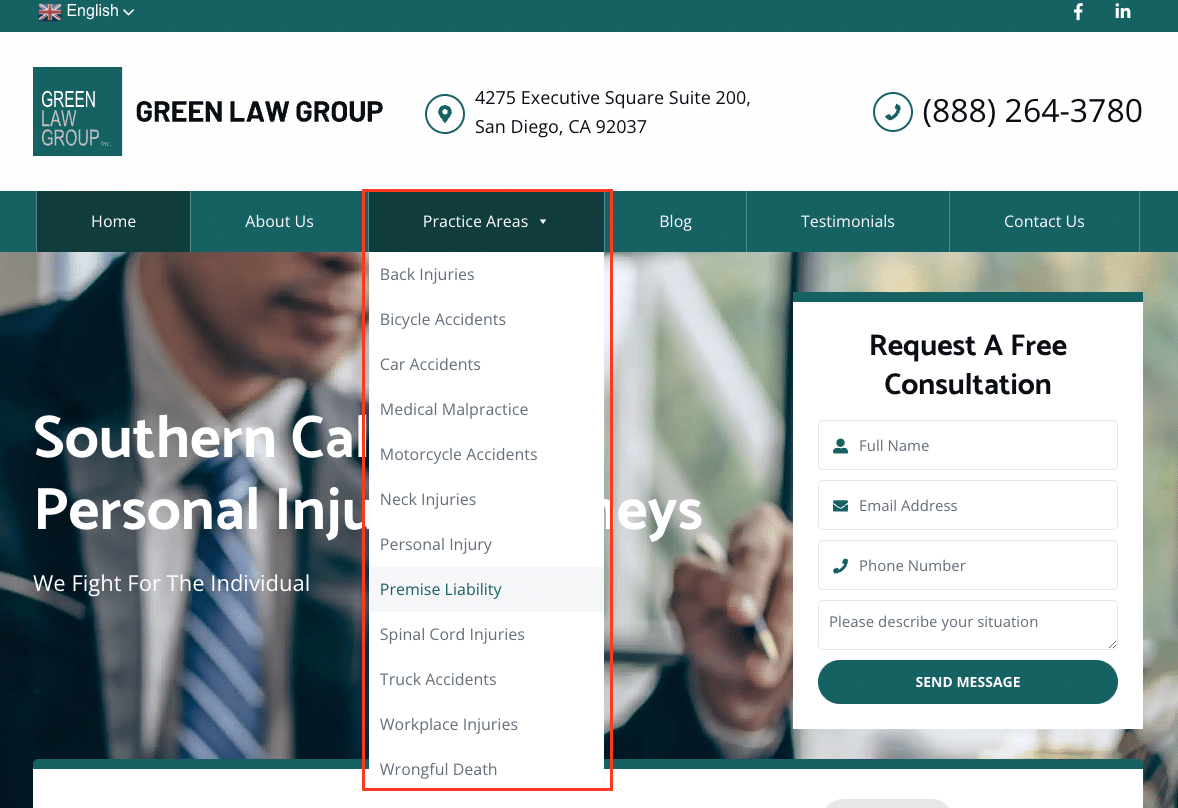
In addition to your home page, practice area pages can answer specific questions that your potential clients might have about your services, including your location, business hours, and phone number.
Case studies and results
Case studies refer to past client work and how your expertise resulted in a winning case. This type of content is effective in converting potential clients because they prove your experience and expertise in your field.
Be mindful of ABA rules and specific state laws about writing and talking about past court cases. These laws uphold lawyer-client confidentiality, so it’s important that you don’t reveal client information in your case results.
Our client, Stroleny Law, has a “Case Results” page on their website but withholds personal information:
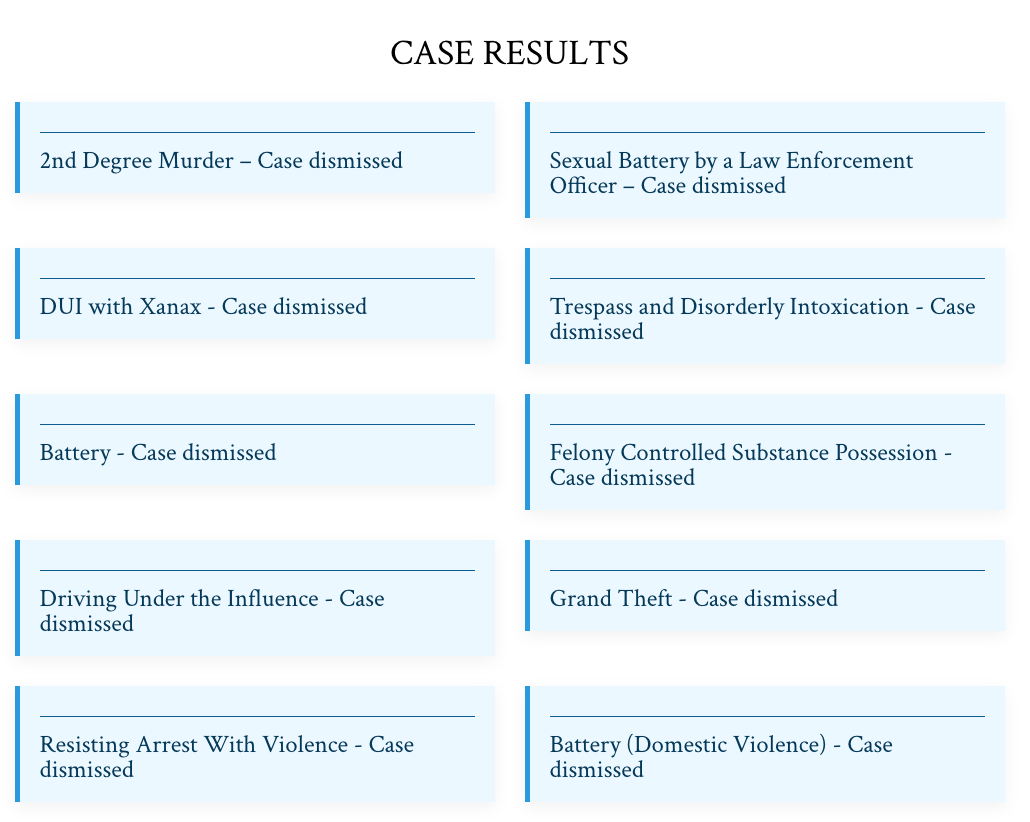
FAQs
The Frequently Asked Questions (FAQ) pages help website visitors, and searchers get answers for commonly asked queries. These pages add value to your law firm’s website because they address immediate concerns and earn the trust of potential clients.
FAQ pages can also appear as a featured snippet in Google search results, such as this query about filing a personal injury claim in California:
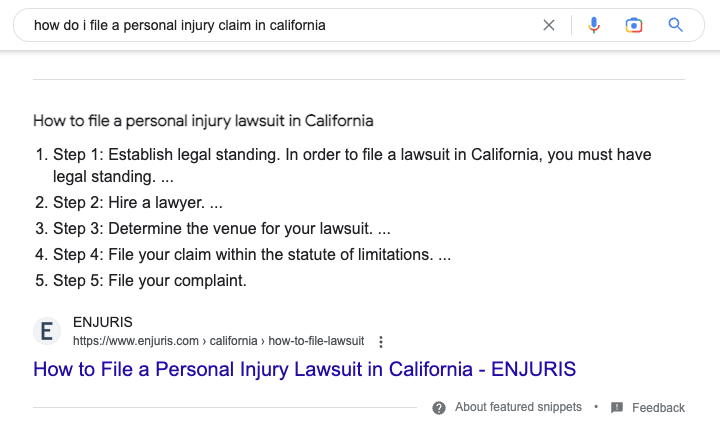
Google recommends using FAQ schema when creating these pages. In layman’s terms, you need your FAQ page to be coded so that the Google search algorithm can recognize it as an FAQ page (with answers and questions).
This errs on the technical side of web development, and it’s highly recommended to hire professional web designers to do this for you.
Images
Your law firm should have a brand and identity. Using images on your home pages help show your visitors the face behind the business.
Your home page, for instance, is a prime spot for an image that best defines your firm’s brand. One of our clients, personal injury lawyer Jesse Minc, includes a professional photo of him on his law firm website.

Compared to a block of text, adding images to your content adds authenticity and makes a deeper connection with your audience.
Infographics
Infographics are visual aids that support a concept. You usually create these images as part of an article, showing research and statistics.
Here’s an example of an infographic about divorce that family lawyer Karen Covy used in a blog post.
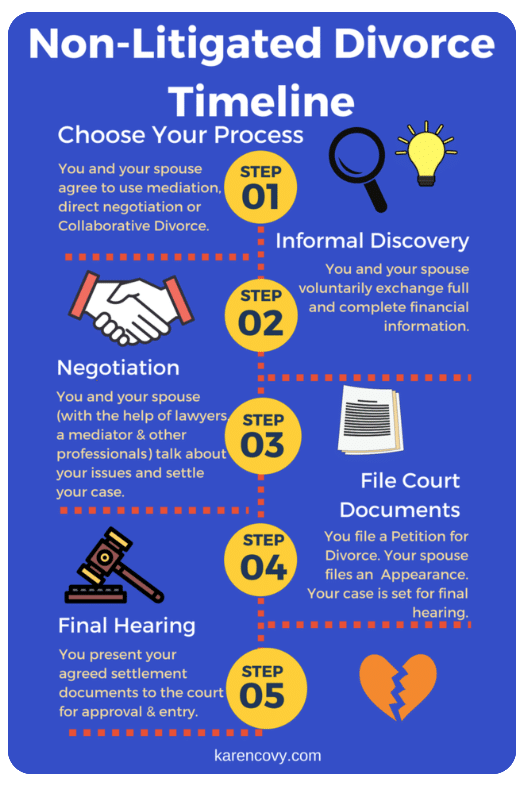
Infographics provide an effective way of teaching a complicated topic like family law in just a few seconds. They’re also known as a great tactic for link building, which is the process of getting other sites to link back to you (called backlinks).
Explainer and commercial videos
You can add videos to your content marketing strategy to provide more value to your audience. Law firm web pages that include videos like explainers attract people who prefer watching videos to reading articles.
Personal injury firm Wattel & York created a Video Center page for their law firm website, which features several topics about their firm and practice areas.
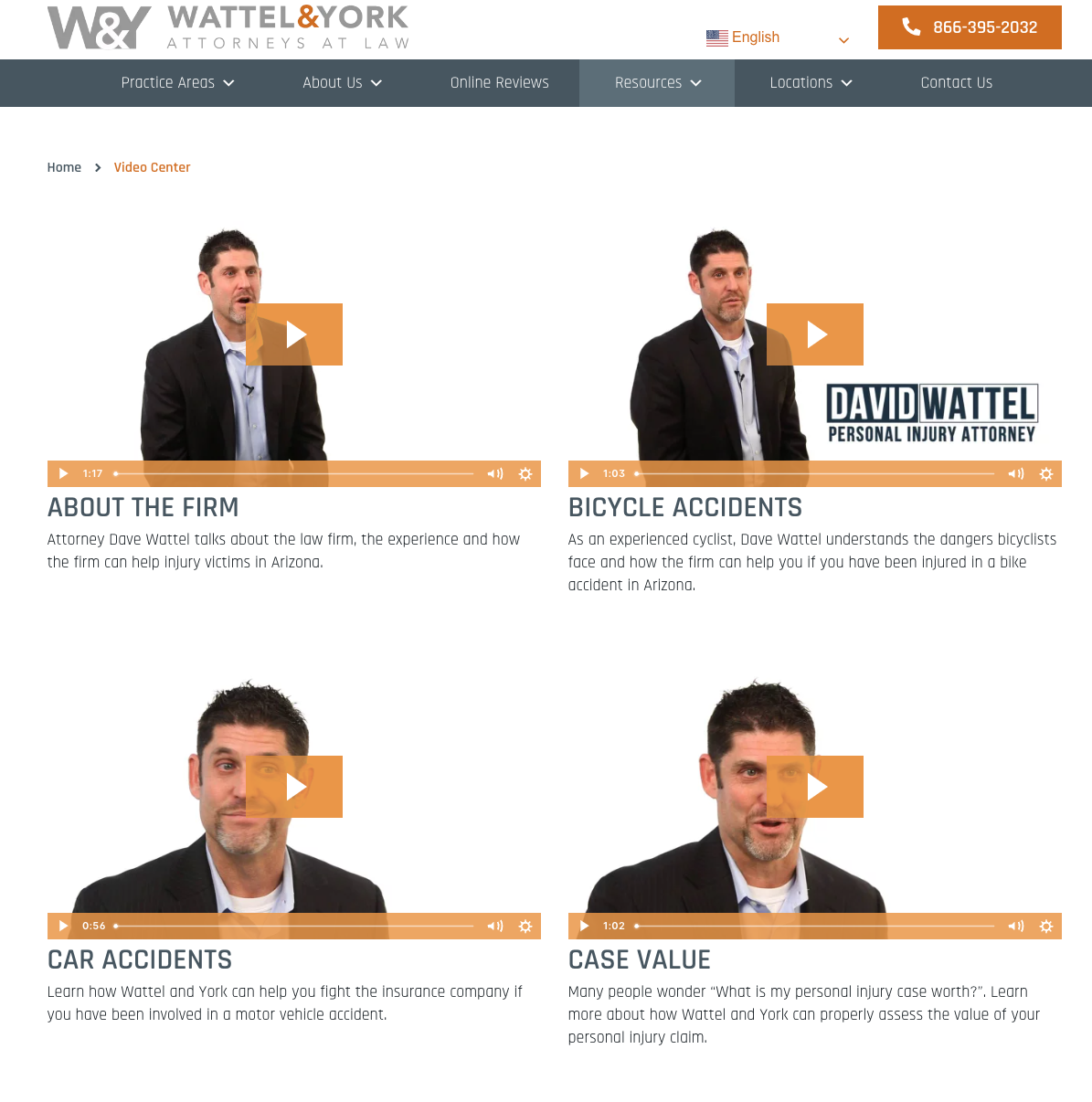
How to optimize your content to get more conversions and organic traffic
Optimizing your content happens with many steps, which start with creating an SEO strategy for your law firm. Writing quality content is also important to ensure that you’re not just writing for search engines, but for your target audience.
Research and understand your audience
Before thinking about what content to write, you’ll need to know what people are searching for related to your firm’s legal services. For this, you’ll need to conduct keyword research using a tool like Google Keyword Planner. This tool (and others) will show you how many people are searching for a specific keyword.
From your keyword research, you can decide which keywords to use in your content. This is a basic step in your law firm’s SEO strategy, but it’s essential that you choose the right keywords.
In the example below, a search for “car accident lawyer” generates more keyword suggestions and shows the search volume and the difficulty of ranking in search engine results pages (SERPs).

Choosing keywords with good search volume but low competition is a good strategy. Note that you’ll need to track your content and get enough data to check if the strategy is working.
Document your content strategy
To always have a unifying theme to your content, you’ll need to write down your content strategy.
Some of the questions you’ll need to answer in your content strategy document would be:
- Who is your audience?
- What is your brand/story?
- Why should people hire you?
- How will you help people achieve their goals?
These are just a few questions to start writing your content strategy. You can add more as you see fit to your overall law firm marketing goal.
Create a content calendar
A content calendar is where you plot when to publish content on your blog or social media accounts like LinkedIn. Essentially, it’s a publishing schedule that you are able to see visually using a calendar.
You can use free calendar apps or paid ones like Hootsuite.
Whatever tool you use, it’s important to remember what type of content you choose to write, you need to make sure of the following:
- Content should have business potential – This simply means your content should be aligned with your services. For instance, a personal injury law firm has no business publishing content about real estate settlements when that is not what they offer.
- Content should target keywords with traffic potential – As mentioned in the previous section, aim for keywords with substantial search volume. If you want to get accurate data on a keyword’s traffic potential, you can use a tool like Ahrefs.
It’s not enough to create content just to perform in search engine rankings but don’t convert. Your blog content, for instance, should always have the likely chance of attracting new clients and continuously bringing in leads. This is why your content strategy should emphasize content quality and relevance.
5 quick tips on content creation and optimization for lawyers
Satisfy user intent
User intent in digital marketing means what the user intends with the information that he/she searches for online. If a person types “divorce lawyer near me,” it’s safe to assume that this person wants to consult with a divorce lawyer in his area.
For your content strategy, include keywords with high user intent. The words “best”, “near me”, and “pricing” are commonly attached to the search query they’re making.
Make your content accessible and engaging
Another consideration when making content is to make it accessible to everyone, including people with disabilities like visual impairments. Your website design should be easy to understand even when using assistive technologies like screen readers.
One example of optimizing content for accessibility would be to use accurate descriptions in your alternative text (alt-text) for images so blind people know what the image is.
Your content should also be engaging. Use images along with text to help readers understand concepts. Write to keep your reader’s attention so that they’ll read through the entire content. If writing is not your expertise, hire a content marketing agency to do this for you.
Use the pillar content strategy
The pillar content strategy involves writing pillar content, which several sub-topics will come from. Pillar content is usually evergreen, which means it’s something that will be relevant even after years have passed. It’s also content that has an important target keyword that you’re aiming to rank in SERPs.
Demonstrate E-E-A-T on your website
E-E-A-T stands for Experience, Expertise, Authoritativeness, and Trustworthiness. This is Google’s criteria for its search quality rater guidelines, which evaluates content published on the web.
Your content should be created by someone who has first-hand experience with the topic. To demonstrate this, there should be an author and an author profile that highlights why they are considered experts in the topic they wrote about.
Below is an example of a concise but compelling author bio of Jay Sadanandan from the UK-based firm Latham & Watkins.

Following the E-E-A-T standard makes your content credible and earns the trust of your audience.
In a recent podcast episode, our SEO manager, Isadora Padoa, broke down the E-E-A-T audit we use for attorneys. Listen to it below to learn how you can integrate it on your website:
Keep updating stale content
Google loves fresh content. It’s a proven ranking factor. So regularly revisit your website and update content that starts experiencing ranking drops. Any changes that happen within your firm and in the legal industry should reflect on your content platforms, including your blogs, LinkedIn page, and other social media channels.
Track your content performance and iterate your content optimization efforts
After a few months of publishing content, you need to create a method for tracking your content’s performance and making the necessary improvements based on your findings.
You can use a free tool like Google Analytics to measure your website’s performance. You can view website visits, new vs. returning visitors, and other user behavior metrics that help you gain more insights into which of your content is getting the most traffic. We discuss some KPIs you can use in your SEO tracking in one of the following chapters.
Other metrics like engagement and bounce rates tell you whether or not your website visitors have an ideal user experience when navigating your site.
Once you get the hang of analyzing content quality, you’ll know what type of content your audience likes. As a result, you’ll get better at creating content that generates leads and grows your attorney business.
Do you need help creating and optimizing content for your law firm? Contact us today to get started!
SEO for Lawyers: (Step-by-Step) Law Firm SEO Guide
-
Ch 1
SEO for Law Firms
Read Article
-
Ch 2
Lawyer SEO Ranking Factors
Read Article
-
Ch 3
Legal Keyword Research
Read Article
-
Ch 4
Link Building for Attorneys
Read Article
-
Ch 5
Legal Content Optimization
Read Article
-
Ch 6
Local SEO for Lawyers
Read Article
-
Ch 7
GMB for Law Firms
Read Article
-
Ch 8
Tracking SEO Results
Read Article
-
Ch 9
Lawyer SEO Stats
Read Article
3